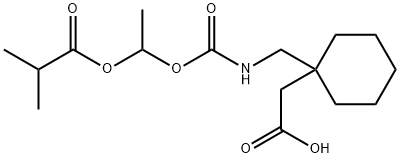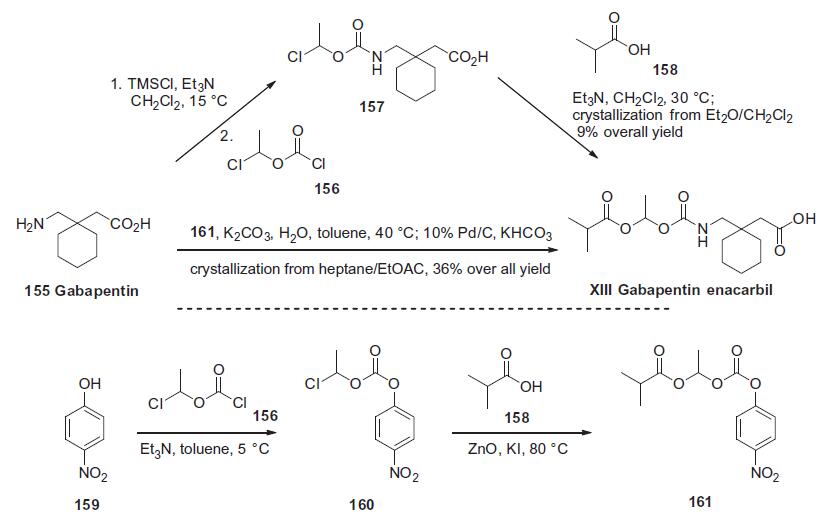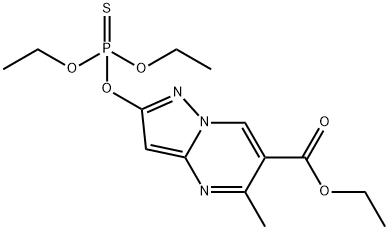Gabapentin enacarbil
- CAS NO.:478296-72-9
- Empirical Formula: C16H27NO6
- Molecular Weight: 329.39
- MDL number: MFCD09954124
- SAFETY DATA SHEET (SDS)
- Update Date: 2025-03-17 20:18:22

What is Gabapentin enacarbil?
Absorption
Gabapentin enacarbil is absorbed in the intestines by active transport through the proton-linked monocarboxylate transporter, MCT-1.
Toxicity
Most common adverse reactions are headache, dizziness, and somnolence.
Description
Gabapentin enacarbil (GEn) is an actively transported prodrug of gabapentin that provides sustained doseproportional exposure to gabapentin and predictable bioavailability. In April 2011, Gabapentin enacarbil is approved by the US Food and Drug Administration for the treatment of moderate-to-severe primary restless legssyndrome (RLS) in adults.
Gabapentin enacarbil was designed to be recognized as a substrate for two high-capacity nutrient transports, monocarboxylate transporter type 1 and sodium-dependent multivitamin transporter, and to be efficiently cleaved after absorption to give gabapentin. The separated enantiomers of gabapentin enacarbil have similar cleavage rates in human tissues. Preclinical studies showed that gabapentin enacarbil provides good systemic exposure of gabapentin in rats and monkeys.
Originator
Xenoport (United States)
The Uses of Gabapentin enacarbil
Gabapentin enacarbil (HORIZANT GlaxoSmithKline/XenoPort) is a prodrug of gabapentin used as an anticonvulsant as well as a treatment for neurogenic pain, with the same mechanism of action as pregabalin.
Indications
For the treatment of adult Restless Legs Syndrome (RLS) and postherpetic neuralgia (PHN).
Background
Gabapentin enacarbil is marketed under the name Horizant. It is a prodrug of gabapentin, and indicated in adults for the treatment of Restless Legs Syndrome (RLS) and postherpetic neuralgia (PHN).
Definition
ChEBI: A carbamate ester that is the N-[1-(isobutyryloxy)ethoxy]carbonyl derivative of [1-(aminomethyl)cyclohexyl]acetic acid. The prodrug for gabapentin, used for treatment of neuropathic pain and restless legs syndrome.
Preparation
Gabapentin enacarbil is prepared as a racemic mixture from gabapentin either by sequential coupling with 1-chloroethyl chloroformate in the presence of trimethylsilyl chloride and triethylamine followed by addition of isobutyric acid or by direct coupling with an activated 1-(isobutyryloxy) ethyl carbonate.
brand name
Horizant
Pharmacokinetics
Since gabapentin enacarbil is a prodrug of gabapentin, it's physiological effects are the same as gabapentin. Concerning PHN, gabapentin prevents allodynia and hyperalgesia.
Pharmacokinetics
Gabapentin enacarbil is an acyloxyalkylcarbamate prodrug of analgesic and anticonvulsant drug gabapentin which has problematic pharmacokinetic properties, including short half-life, saturable absorption, high inter-patient variability, and lack of linear dose–response relationship. Gabapentin enacarbil was designed to be absorbed throughout the entire length of the gastrointestinal tract, and its absorption is mediated by high-capacity nutrient transporters, including monocarboxylate transporter 1 (MCT-1) and sodium-dependent multivitamin transporter (SMVT). Prodrug modification produced an extended release of gabapentin with twofold improved, more predictable, and dose-proportional oral bioavailability in humans. During and after its absorption, gabapentin enacarbil is efficiently hydrolyzed by nonspecific esterases to yield gabapentin. Currently, gabapentin enacarbil is commercially available for the treatment of restless legs syndrome and post-herpetic neuralgia of adults.
Structure and hydrolysis of gabapentin enacarbil to the active gabapentin
Clinical Use
Gabapentin enacarbil is a prodrug of gabapentin (Neurontin, Pfizer) which binds to the a2-d subunit of L-type voltage-regulated calcium channels, reducing the release of several neurotransmitters. 122,123 Gabapentin enacarbil was discovered at XenoPort, codeveloped with GlaxoSmithKline, is marketed under the brand name Horizant, and is approved for the treatment of moderate to severe restless leg syndrome. Gabapentin enacarbil was designed to increase the absorption of gabapentin through the interaction with sodium-dependent multivitamin transporter (SMVT) and monocarboxylate transporter type 1 (MCT-1). As a result, the drug demonstrated much better oral bioavailability and more consistent exposure compared to the parent.
Synthesis
Gabapentin 155 was treated with chlorotrimethylsilane and triethylamine followed by acylation with 1-chloroethyl chloroformate 156 to give acid 157 after hydrolysis of the intermediate silyl ester. This acid was then used without purification and reacted with isobutyric acid (158) and triethylamine to afford gabapentin enacarbil (XIII) in 9.1% overall yield after crystallization. Alternatively, gabapentin 155 was reacted directly with the fully elaborated p-nitrophenyl activated side chain 161 in the presence of potassium carbonate. The resulting mixture of products and p-nitrophenol was treated with 10% Pd/C and potassium formate followed by acidic workup to remove the resulting aniline, providing gabaentin enacarbil (XIII) in 36% overall yield from p-nitrophenol 159 after crystallization. The required activated side chain 161 was prepared from p-nitrophenol 159 via a two-step, one-pot process involving acylation of the phenol with 1-chloroethyl chloroformate 156 in triethylamine. This provided intermediate 160 which was alkylated with isobutyric acid (158) in the presence of zinc oxide and potassium iodide, ultimately furnishing the mixed carbonate 161.

Metabolism
Gabapentin enacarbil does not interact with any of the major cytochrome P450 enzymes.
Mode of action
Gabapentin enacarbil is a prodrug of gabapentin and, accordingly, its therapeutic effects in RLS and PHN are attributable to gabapentin.
The mechanism of action by which gabapentin is efficacious in PHN is unknown but in animal models of analgesia, gabapentin prevents allodynia (pain-related behavior in response to a normally innocuous stimulus) and hyperalgesia (exaggerated response to painful stimuli). Gabapentin prevents pain-related responses in several models of neuropathic pain in rats and mice (e.g., spinal nerve ligation models, spinal cord injury model, acute herpes zoster infection model). Gabapentin also decreases pain-related responses after peripheral inflammation (carrageenan footpad test, late phase of formalin test), but does not alter immediate pain-related behaviors (rat tail flick test, formalin footpad acute phase). The relevance of these models to human pain is not known.
Properties of Gabapentin enacarbil
| Melting point: | 65 °C |
| Boiling point: | 482.0±20.0 °C(Predicted) |
| Density | 1.134 |
| storage temp. | Store at -20°C |
| solubility | DMSO:100.0(Max Conc. mg/mL);303.59(Max Conc. mM) Ethanol:100.0(Max Conc. mg/mL);303.59(Max Conc. mM) Water:0.67(Max Conc. mg/mL);2.03(Max Conc. mM) |
| form | Powder |
| pka | 4.72±0.10(Predicted) |
| color | Light yellow to brown |
| CAS DataBase Reference | 478296-72-9(CAS DataBase Reference) |
Safety information for Gabapentin enacarbil
| Signal word | Warning |
| Pictogram(s) |
 Exclamation Mark Irritant GHS07 |
| GHS Hazard Statements |
H302:Acute toxicity,oral H315:Skin corrosion/irritation H319:Serious eye damage/eye irritation H335:Specific target organ toxicity, single exposure;Respiratory tract irritation |
| Precautionary Statement Codes |
P261:Avoid breathing dust/fume/gas/mist/vapours/spray. P280:Wear protective gloves/protective clothing/eye protection/face protection. P301+P312:IF SWALLOWED: call a POISON CENTER or doctor/physician IF you feel unwell. P302+P352:IF ON SKIN: wash with plenty of soap and water. P305+P351+P338:IF IN EYES: Rinse cautiously with water for several minutes. Remove contact lenses, if present and easy to do. Continuerinsing. |
Computed Descriptors for Gabapentin enacarbil
Gabapentin enacarbil manufacturer
Molsyns Research
New Products
3-Iodophenylacetic acid 3-Pyridineacetonitrile, α-hydroxy- 2-Propanamine, 1-chloro-, hydrochloride (9CI) 3-(hexyloxy)-4-(pyridin-3-yl)-1,2,5-thiadiazole 2-Hexyn-1-ol Dibenzo-18-crown-6 Nickel(II) perchlorate hexahydrate, 98% 4-Bromophenylacetonitrile, 95% 3-Bromo-4-fluoroaniline, 97% Sodium tetraborate decahydrate, 98% Palladium(II) acetate, trimer, Pd 99% 4-Bromo-2-chlorotoluene, 97% N N Dimethylformamide Dimethyl Acetal (Dmf Dma) 2,3-Dichloro Benzoyl Cyanide [Side Chain] Bis(2-Chloroethyl) Amine Hydrochloride L-Glutamic Acid Diethyl Ester Hydrochloride 5-(Difluoromethoxy)-2-Mercaptobenzimidazole 1-Ethyl-3-(3-Dimethylaminopropyl)-Carbodiimide Hydrochloride [EDC Hcl] 1,4-Napthoquinone Bromoiodomethane Sodium Bicarbonate Methylene Dichloride (MDC) Ethyl Acetate Indole-3-Carbinol (I3C)Related products of tetrahydrofuran








You may like
-
 478296-72-9 Gabapentin enacarbil 98%View Details
478296-72-9 Gabapentin enacarbil 98%View Details
478296-72-9 -
 Gabapentin enacarbil 98%View Details
Gabapentin enacarbil 98%View Details
478296-72-9 -
 Gabapentin enacarbil 478296-72-9 99%View Details
Gabapentin enacarbil 478296-72-9 99%View Details
478296-72-9 -
 478296-72-9 Gabapentin enacarbil 98%View Details
478296-72-9 Gabapentin enacarbil 98%View Details
478296-72-9 -
 Gabapentin Enacarbil 478296-72-9 98%View Details
Gabapentin Enacarbil 478296-72-9 98%View Details
478296-72-9 -
 Gabapentin enacarbil 95% CAS 478296-72-9View Details
Gabapentin enacarbil 95% CAS 478296-72-9View Details
478296-72-9 -
 Gabapentin Enacarbil CAS 478296-72-9View Details
Gabapentin Enacarbil CAS 478296-72-9View Details
478296-72-9 -
 132945-75-6 (S)-1-Boc-3-methanesulfonyloxy-pyrrolidine 98+View Details
132945-75-6 (S)-1-Boc-3-methanesulfonyloxy-pyrrolidine 98+View Details
132945-75-6
